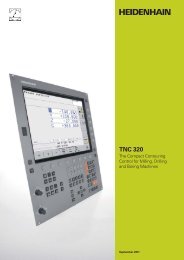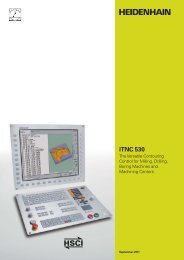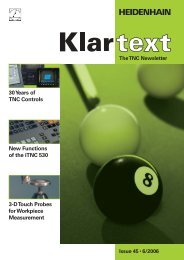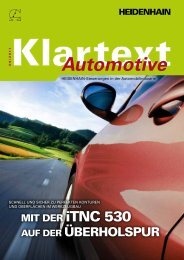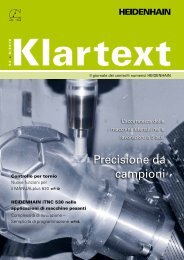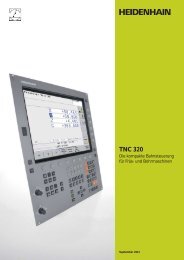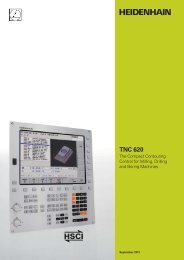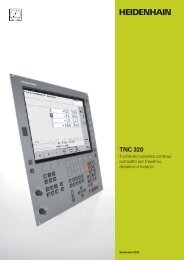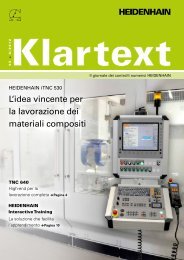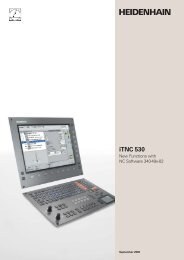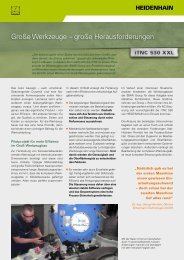Klartext 47 - TNC 640 - Heidenhain
Klartext 47 - TNC 640 - Heidenhain
Klartext 47 - TNC 640 - Heidenhain
You also want an ePaper? Increase the reach of your titles
YUMPU automatically turns print PDFs into web optimized ePapers that Google loves.
<strong>Klartext</strong> + Issue <strong>47</strong> + 09/2007 1<br />
Flexible use of tools<br />
with the B axis<br />
If your machine is equipped with a<br />
B axis, you can use your tools much<br />
more efficiently than before. On conventional<br />
lathes you need four different<br />
tools for longitudinal and transverse<br />
turning on opposing spindles. With a<br />
B axis, you can do it with a single tool.<br />
You simply tilt the B axis and rotate the<br />
tool to the normal position or for machining<br />
from behind the workpiece—<br />
whichever is required for longitudinal or<br />
transverse turning on the main or opposing<br />
spindle. All you need is a single<br />
call. The CNC PILOT calculates the tool<br />
lengths, the tool angle and the other<br />
tool data for you.<br />
Tool-use flexibility is increased significantly<br />
when several tools are mounted<br />
in one holder. For example, with a<br />
roughing, finishing and recessing tool<br />
you can perform considerable parts of<br />
turning and recessing operations on a<br />
main and opposing spindle—without<br />
changing the tool. And programming<br />
is very easy. You simply indicate which<br />
tooth of the tool to use and then define<br />
the tilting angle and the tool position.<br />
And that’s it, because the CNC PILOT<br />
already has the rest position and the<br />
data of each tool tooth in its database.<br />
This type of flexibility lowers the number<br />
of tools, and you save valuable machining<br />
time by reducing the number of<br />
tool changes.<br />
Lathes with multiples slides<br />
and B axis<br />
The B axis not only significantly increases<br />
the range of parts that can be<br />
produced on a lathe, but the machine<br />
productivity is also improved due to<br />
the flexible use of tools. Since a B axis<br />
is usually used on lathes with multiple<br />
slides and spindles, the NC programmer<br />
is faced with the challenge of optimally<br />
distributing the machining tasks<br />
over the various available slides and<br />
spindles.<br />
The CNC PILOT offers support with<br />
various programming and monitoring<br />
functions. For example, creating a<br />
program for machining the rear side is<br />
made easy by mirroring and/or shifting<br />
the contour, as well as by converting<br />
specific NC commands for machining<br />
with the opposing spindle. In addition,<br />
the assignment of program sections to<br />
slides or spindles also helps to give the<br />
part program a clear structure.<br />
Simulation<br />
The graphic simulation feature of the<br />
CNC PILOT 4290 supports the monitoring<br />
of complex machines and facilities.<br />
The control shows all workpieces and<br />
the tool movements of all slides in the<br />
simulation window. The CNC PILOT<br />
4290 takes the entire machining zone<br />
into consideration. Tools and chucking<br />
equipment are shown to scale.<br />
The graphic simulation is characterized<br />
by a high degree of flexibility. You can<br />
define what is shown in the simulation<br />
window. You can specify whether the<br />
window for lathe machining is shown,<br />
for the end face or the lateral surface,<br />
the side view with B-axis machining, or<br />
a combination of these windows.<br />
With the help of this support, you can<br />
effectively and comprehensively program<br />
and check complex, multi-slide<br />
programs—even before making the<br />
first cut.<br />
Synchronous point analysis<br />
During the simulation, the CNC PILOT<br />
4290 saves the productive, non-productive<br />
and idle times, as well as all tool<br />
changes and synchronization points.<br />
Based on this information the synchronous<br />
point analysis shows the chronological<br />
sequence of the machining,<br />
and the interdependency of the slides.<br />
This serves to make the sequence of<br />
the workpiece machining steps more<br />
transparent, which is a good basis for<br />
the NC programmer to analyze and<br />
optimize the machining of the<br />
workpiece.



